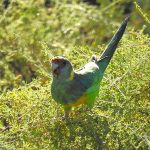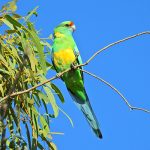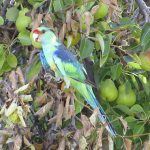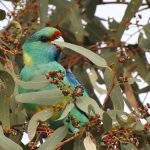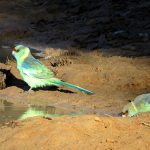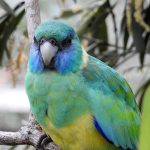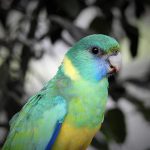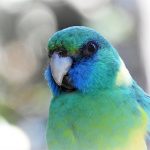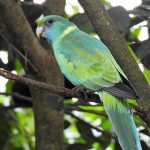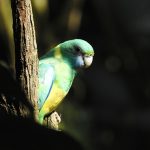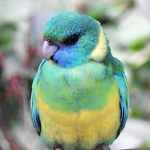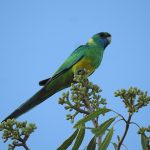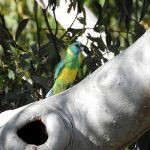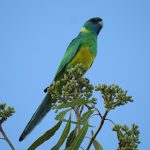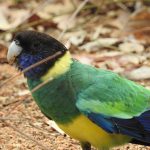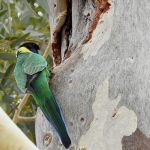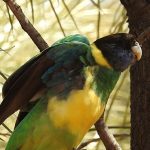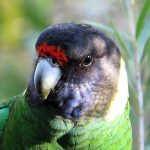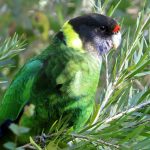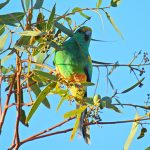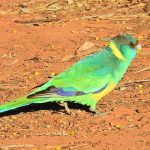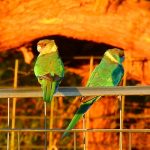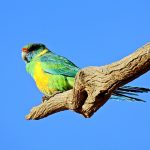AUSTRALIAN RINGNECK PARROT
The Australian Ringneck Parrot: A Tale of Colour and Adaptation
In the dappled sunlight of Australia’s woodlands, a flash of emerald and sapphire might catch your eye. This is the Australian Ringneck Parrot—a bird whose vibrant plumage and lively calls have woven it into the fabric of Australia’s diverse ecosystems, as well as its cultural heritage.
A Portrait in Colour
Imagine standing quietly among eucalyptus trees as the air fills with the gentle rustle of feathers and the musical chatter of parrots. The Australian Ringneck Parrot measures about 30 to 36 centimetres from its curved beak to the tip of its elongated tail. Its feathers are a living canvas, painted in brilliant greens with splashes of yellow, blue, and sometimes orange or red, depending on the subspecies.
Mallee Ringneck subspecies barnardi has deep green body, pale yellow belly, blue forehead
Port Lincoln Parrot subspecies zonarius has green body, yellow collar, blue face
Twenty-eight Parrot subspecies semitorquatus has duller green, red frontal band
The Cloncurry subspecies macgillivrayi has much more yellow and pale turquoise around the face.
Living Across a Continent
The Australian Ringneck Parrot is endemic to Australia, thriving in a mosaic of habitats:
Woodlands and forests: Their calls echo between tall trees, creating a symphony with the wind and rustling leaves.
Scrublands and mallee: Here, they dart between shrubs, foraging for seeds and berries among the soft scent of eucalyptus.
Urban gardens and parks: Their adaptability means you might spot them feeding on fruiting trees or lawn seeds, their presence bringing a splash of wild colour to city life.
Their range stretches from the southern edges of Western Australia and South Australia, across the arid interior, to the eastern woodlands—each region shaping the unique hues and calls of its local parrots.
Social Lives and Communication
In the early morning, listen for their clear whistles and lively squawks. Australian Ringneck Parrots are highly social, gathering in small flocks or larger groups. Their calls serve as both a greeting and a warning—a complex language of the treetops.
Vocalisations: Short, ringing calls and softer contact notes that echo through the bush.
Flock behaviour: Watch as they move in synchrony, wings flashing, always alert to changes in their environment.
Diet and Feeding Habits
Australian Ringneck Parrots are resourceful feeders:
Seeds and nuts: The strong, hooked beak is specially adapted to crack open tough shells, revealing the rich seeds inside.
Fruits and berries: Their tongues and beaks allow them to taste the sweet flesh and extract nutrients.
Flowers and nectar: Dipping into blossoms, they play a role in pollination, helping plants to reproduce.
Occasional insects: Providing extra protein, especially during the breeding season.
Their foraging creates a gentle rustle in leaf litter, and the scent of crushed seeds lingers in the air.
Life Cycle and Breeding
The rhythm of the seasons guides their breeding:
Nesting: August to December is the main breeding period. Pairs search for tree hollows, often in ancient eucalypts, where the soft smell of wood and the filtered light create a safe haven.
Eggs: A typical clutch contains 3 to 6 eggs, white and smooth, incubated for about 21 days by both parents.
Chick Rearing: The chicks are born helpless, eyes closed, relying on their parents for warmth and food.
Fledging: After 4 to 5 weeks, young parrots take their first flight, their feathers gleaming in the sunlight, and soon begin to explore the world independently.
Conservation and Cultural Significance
At present, the Australian Ringneck Parrot is not considered endangered. Yet, like many native species, it faces threats from habitat loss and fragmentation—challenges that remind us of the delicate balance of Australia’s ecosystems.
Conservation Message:
By protecting mature trees with nesting hollows, preserving native woodlands, and planting diverse native flora, we can ensure future generations will experience the vibrant presence of these parrots.
In Aboriginal cultures, the Australian Ringneck Parrot is more than just a bird. Its colours, calls, and behaviours are woven into stories and totems, reflecting the deep connection between people and the land. The parrot’s bright feathers and spirited presence enliven many traditional stories, serving as symbols of nature’s vitality and resilience.
Encountering an Australian Ringneck Parrot is a sensory delight—the flash of colour, the chorus of calls, the scent of eucalyptus, and the feeling of wonder at nature’s artistry. These parrots are living reminders of Australia’s unique biodiversity and the importance of caring for the wild places they call home.
Every bird, every feather, every call is a story waiting to be discovered. By learning about and protecting these remarkable parrots, we become part of their ongoing story—a story of adaptation, beauty, and hope.
Photo Gallery
Sharon: We were travelling through Central Queensland during a very dry season, where the drought conditions were making water limited for Wildlife & Birds, Creeks and Waterholes were drying up. We did find a dam that was still holding water, so we decided to camp by it for the night. To our delight an amazing array of wildlife wondered in on dusk and dawn. This ‘Close Encounters’ video shows when the Eastern Ringnecks (also known as Mallee Ringnecks) came in for a drink and a bath.
Sharon: We often find campsites in Cloncurry Ringneck Country in Outback Australia, as there is always some amazing ‘Aussie Critters’ to see. It’s usually pretty quiet and when the rivers run the birds and wildlife spring into breeding season.

